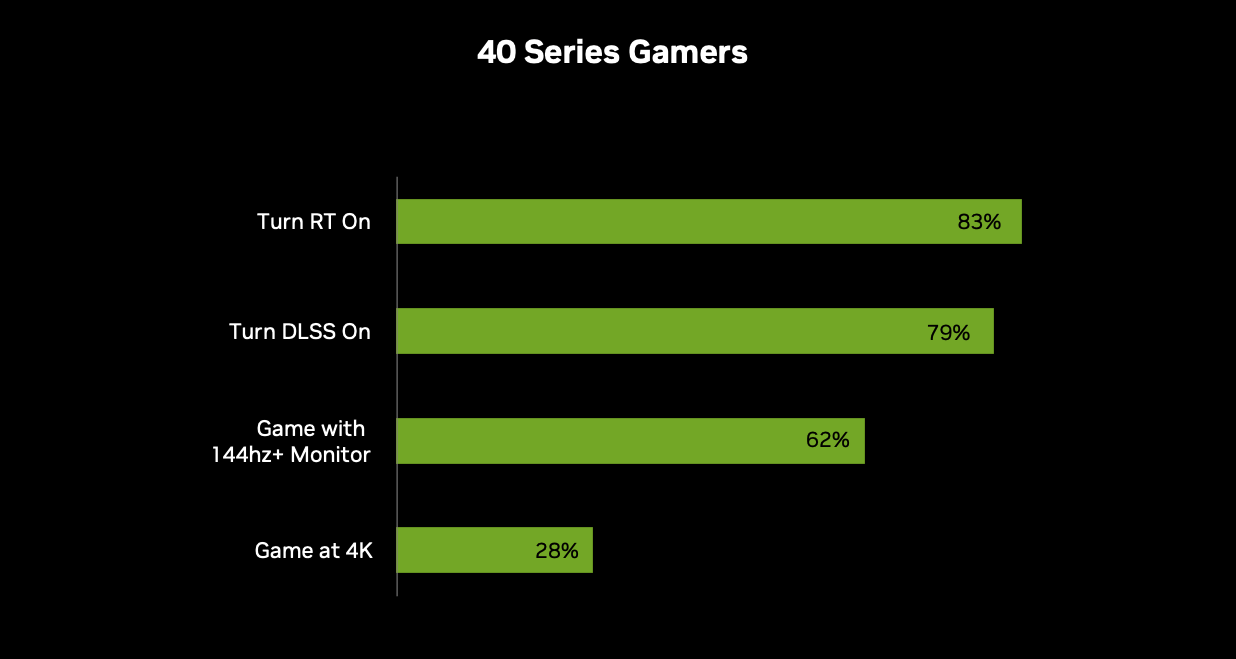Nvidia says 83% of RTX 40-series gamers enable ray tracing
Which conversely means 20% never use either that or DLSS. Who'd a thunk it?!

No fewer than 83% of GeForce RTX 40 GPU owners enable ray tracing and 79% of them crank up DLSS. So says Nvidia itself courtesy of data collected through GeForce Experience.
If you're wondering how that compares with older RTX 30 and 20-series cards, well, Nvidia has numbers for those, too.
"79% of 40-series gamers, 71% of 30-series gamers and 68% of 20-series gamers turn DLSS on. 83% of 40 Series gamers, 56% of 30-series gamers and 43% of 20-series gamers turn ray tracing on," says Nvidia.
Nvidia's conclusion from all this? "That’s why it’s essential to consider both ray tracing and DLSS when evaluating an RTX 40 Series upgrade — which is how today's gamers achieve the best graphics and performance."
Among other interesting data points are some screen tech insights. 62% of RTX 40 owners have a 144Hz-plus capable monitor, while just 28% game at 4K.
Of course, some typically cynical wags on Reddit have commented that these figures may not be quite what they seem. The gist goes something like this. User turned on ray tracing. User turned off ray tracing. Boom! Chalk one up for the ray-tracing column, because look, they turned it on!
Nvidia doesn't provide any details as to what it takes to qualify as an RTX gamer who enables either DLSS or ray tracing. Could a brief experimentation as implied above qualify? We simply do not know.
The biggest gaming news, reviews and hardware deals
Keep up to date with the most important stories and the best deals, as picked by the PC Gamer team.

It's certainly fair to say that without disclosing what games these numbers apply to and how long gamers used RT settings and so whether they stuck with ray tracing for the long haul, the simple fact that 83% of gamers with RTX 40 GPUs turned ray tracing on at some point, which is all we know for sure from the data, doesn't mean a whole lot.
The comparative numbers with earlier generations and the uptick in usage is interesting, but again doesn't necessarily imply anything straightforward. Back in 2018 Nvidia states that 37% of RTX 20-series gamers enabled ray tracing (in the four games that used it back then) and just 26% enabled DLSS.
You could argue that the increased RT usage on RTX 40 cards makes sense given that those GPUs offer better ray-tracing performance than earlier generations. But if that is what's driving higher RT usage on RTX 40 GPUs, why is DLSS usage lower progressively on older generations? Admittedly, it wasn't as good back then as it is today.

Best CPU for gaming: The top chips from Intel and AMD
Best gaming motherboard: The right boards
Best graphics card: Your perfect pixel-pusher awaits
Best SSD for gaming: Get into the game ahead of the rest
You might expect upscaling usage to be more prevalent on older GPUs that need more help attaining decent frame rates. But nope. RTX 30-series GPU owners still use DLSS less than RTX 40 owners, and RTX 20 owners use it less still.
We could speculate that existing RTX 40 cards out in the wild (the data relates to February this year) are high-end models more likely to be owned by switched on enthusiasts aware of these features, whereas older GPUs are perhaps more mainstream and more likely to be used by gamers who simply run at whatever settings the game throws up by default and don't dig too deeply into the graphical options.
This is, indeed, Nvidia's take when we spoke to the company about the numbers ahead of the RTX 4070 launch. That could easily be why, some RTX 20 owners are overlooking the benefits of DLSS. But unless Nvidia is able to provide a more detailed breakdown of the figures, we simply won't know the specifics.
Either way, there's certainly little doubt that both upscaling and ray tracing are becoming increasingly critical features for modern graphics cards, however you want to interpret this data.

Jeremy has been writing about technology and PCs since the 90nm Netburst era (Google it!) and enjoys nothing more than a serious dissertation on the finer points of monitor input lag and overshoot followed by a forensic examination of advanced lithography. Or maybe he just likes machines that go “ping!” He also has a thing for tennis and cars.

